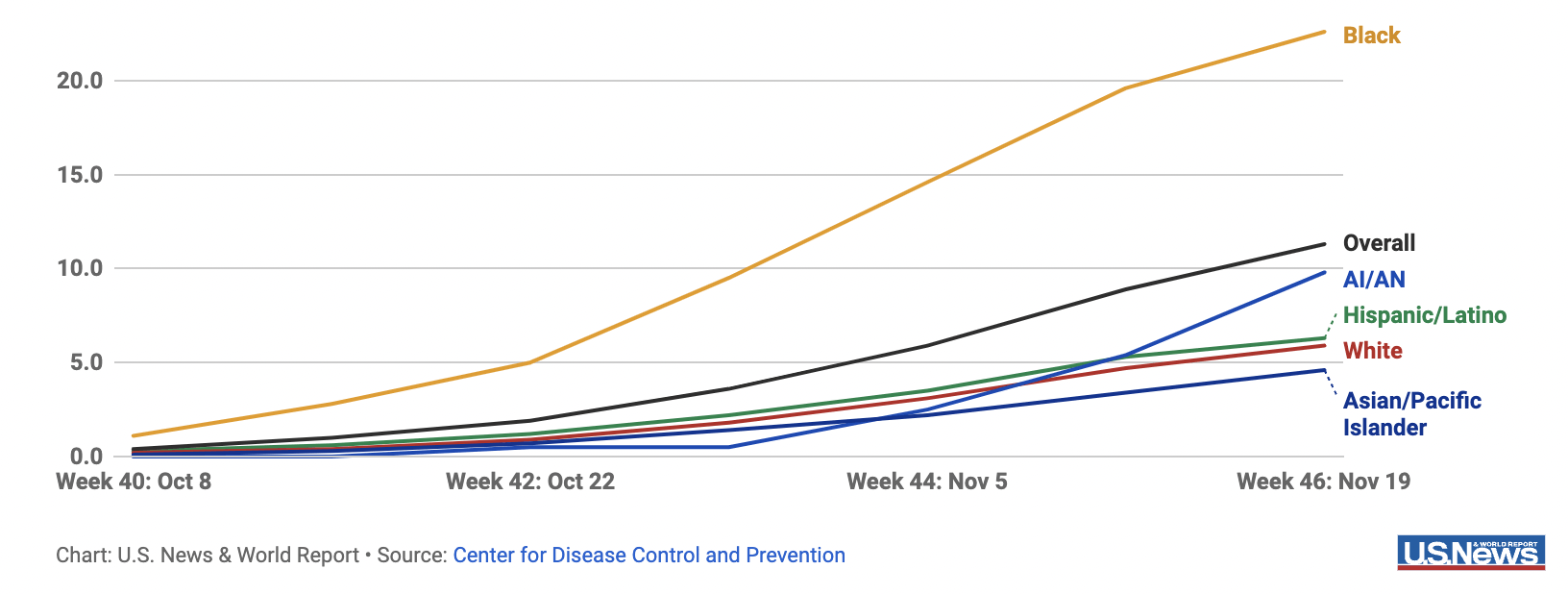The Flu Is Hitting Black Americans Particularly Hard
Data indicates black people are already being hit hardest during what experts fear could be a severe flu season in the U.S.
Preliminary data culled from a network representing approximately 29 million people showed the cumulative hospitalization rate for Black patients with the flu as of Nov. 19 was nearly 4 times higher than the respective rate for white patients, at 22.6 per 100,000 population compared with 5.9 per 100,000.
While the flu historically has impacted minority populations more than others – and it's worth noting that prior data can be adjusted as new information comes in, so numbers reported here may fluctuate – this marks the first time since 2010 that the rate for Black patients has been more than three times the respective rate of white patients at this point in the season.
2022 Flu Hospitalization Rate per 100,000 by Race Group

The Centers for Disease Control and Prevention tracks flu hospitalization rates using the Influenza Hospitalization Surveillance Network, which currently collects data from more than 70 counties across 13 states and represents about 9% of the U.S. population. Additional counties in other states have contributed data over the years. The CDC typically monitors flu rates from early October to late April of the following year, reporting figures for each “MMWR week.”
The flu seems to have hit the Black population within the surveillance network especially hard this season, even as rates across the board have spiked higher – and earlier – than in recent years. In late October, the CDC noted that the U.S. had seen little flu activity during the past two seasons – which fully coincided with the COVID-19 pandemic – and warned that “reduced population immunity, particularly among young children who may never have had flu exposure or been vaccinated, could bring about a robust return of flu.” As of Nov. 28, the CDC estimated there had been at least 6.2 million illnesses, 53,000 hospitalizations and 2,900 deaths overall this flu season.
In the 2019-2020 flu season, for example, the overall hospitalization rate captured by the surveillance network as of Nov. 9 (or week 45) was 1.1 per 100,000 population, while the rate for the Black population was 1.8 for every 100,000 — a disparity of more than 60%. By March 14, close to the season’s peak, the overall rate was 64.3 per 100,000 and the Black cumulative rate was 103 per 100,000 – still a disparity of 60%.
For every flu season for which data is available in the CDC’s hospitalization portal, cumulative Black hospitalization rates have always been higher than that of the total population by the end of the season. Meanwhile, among those 6 months and older, vaccination coverage for seasonal influenza in the Black population has been lower than that of the general population in every corresponding season. The opposite has been true for whites, who saw higher vaccination rates in people 6 months and older and lower hospitalization rates compared with the total population by the end of every season except 2017-2018.
A recent CDC report highlighted the presence of racial or ethnic disparities in flu vaccination and hospitalization rates, citing the need to increase access to health care and combat misinformation as ways to increase vaccination coverage among various communities.
Credit Julia Haines "The Flu Is Hitting Black Americans Particularly Hard", https://www.usnews.com/news/health-news/articles/2022-12-01/the-flu-is-hitting-black-americans-particularly-hard
















